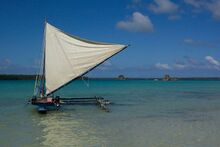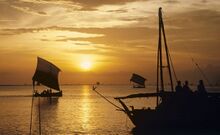Engineering:Kelulus

Kelulus or kalulus is a type of rowing boat used in the Nusantara archipelago. It is typically small in size and propelled using oar or paddle. However, for long-distance voyages, this boat can be equipped with sails.[1]:261 It is not the same as prahu kalulis of the eastern part of the Indonesian archipelago.
Etymology
The name kelulus seems to be derived from Javanese word "lulus", which means "to go right through anything". According to Hobson-Jobson, the literal translation would be "the threader".[2]
Description
The earliest report of kelulus is from Hikayat Raja-Raja Pasai (Chronicle of the Kings of Pasai) of the 14th century, in which they are mentioned as one type of vessel used by the Majapahit empire. Although they are not well described, kelulus is one of Majapahit's main vessel types after jong and malangbang.[3]

From Portuguese sources, they are transcribed as calaluz (calaluzes for plural form), whereby they are described as "A kind of swift rowing vessel used in the Maritime Southeast Asia".[4]:681[5]:557
In about 1500 CE, the Sultanate of Malacca opposed Siam with 200 boats, consisting of lancaran and kelulus. After Sultan Mahmud Shah of Malacca was deposed from Malacca in 1511, he took over Bintan. In 1519 and 1520 he had a fleet consisting of 60 and 100 boats respectively, both being made up of lancaran and kelulus.[6]:212
Tome Pires in 1513 reported that the pates (dukes) of Java has many calaluz for raiding, and described:
... but they are not fit to go out of the shelter of the land. Kelulus were specialty of Java. They are carved in a thousand and one ways, with figures of serpents, and gilt; they are ornamental. Each of them has many of these, and they are very much painted, and they certainly look well and are made in a very elegant way, and they are for kings to amuse themselves in, away from the common people. They are rowed with paddles.
... They go out in triumphal cars, and if they go by sea [they go] in painted calaluzes, so clean and ornamental, with so many canopies that the rowers are not seen by the lord;[7]:200

In 1537, Javanese kelulus encountered in Patani was described as having two rows of oars: One was of short paddles, the other was "like a galley" (long oars); they carried 100 soldiers, with much artillery and firearms. Gonçalo de Souza reported that they have 27 oars and carried 20 soldiers. They are armed with swivel guns (falconselhos) at the bow and stern.[8][9]:158
Spanish dictionary lists them as "Small boat used in the East Indies".
Portuguese historian António Galvão in 1544 made a treatise about Maluku, which lists the types of boats from the region, including the kalulus. He described the hull as being egg shaped at the middle but sloping upwards at both ends. At the prow they are shaped like high snake neck with the head of a serpent and the horns of a deer.[10]:156-157, 162-163
Usage
Kelulus were used as transport vessel or war boat. Majapahit overseas invasion used kelulus, usually in uncountable numbers.[11][3] The pati of Java had many war kelulus for raiding coastal villages. During the Demak Sultanate attack on Portuguese Malacca of 1512–1513, kelulus were used as armed troop transports for landing alongside penjajap and lancaran, as the Javanese junks were too large to approach shore.[12]:74
Queen Kalinyamat of Jepara attacked Portuguese Malacca in 1574 with 300 vessels, 220 of which are calaluzes and the rest were jongs weighing up to 400 tons burthen. The attack ended in failure for the Javanese.[13][6]:212
In 1600, king Chiay Masiuro (or Chiaymasiouro) of Demak embarked in a calelus from Blambangan which has been equipped with oar and sail, to the south. After 12 days, he arrived at Luca Antara or Java Major, which is believed to be Australia . There he received by the syahbandar, and stayed for several days. Chiaymasiuro found out that the inhabitants were Javanese, but with mixed culture of Java, Sunda, and Bali. After he returned to Blambangan, the news of the voyage made great astonishment and public notoriety in Java.[1]:61-63
See also
- Salisipan, a rowing boat from the Philippines
- Tomako
- Waka taua
- Penjajap
- Djong
- Lancaran (ship)
- Kora-kora
- Javanese contact with Australia
References
- ↑ 1.0 1.1 Mills, J. V. (1930). "Eredia's Description of Malaca, Meridional India, and Cathay". Journal of the Malayan Branch of the Royal Asiatic Society 8. https://archive.org/details/in.ernet.dli.2015.281670/page/n1/mode/2up.
- ↑ Yule, Sir Henry (1886). Hobson-Jobson: The Anglo-Indian Dictionary. Wordsworth Editions Ltd.. pp. 143. https://archive.org/details/in.ernet.dli.2015.506702/page/n191/mode/2up?q=.
- ↑ 3.0 3.1 Hill (June 1960). "Hikayat Raja-Raja Pasai". Journal of the Malaysian Branch of the Royal Asiatic Society. 33: p. 98 and 157: "Then he directed them to make ready all the equipment and munitions of war needed for an attack on the land of Pasai – about four hundred of the largest junks, and also many barges (malangbang) and galleys." See also Nugroho (2011). p. 270 and 286, quoting Hikayat Raja-Raja Pasai, 3: 98: "Sa-telah itu, maka di-suroh baginda musta'idkan segala kelengkapan dan segala alat senjata peperangan akan mendatangi negeri Pasai itu, sa-kira-kira empat ratus jong yang besar-besar dan lain daripada itu banyak lagi daripada malangbang dan kelulus." (After that, he is tasked by His Majesty to ready all the equipment and all weapons of war to come to that country of Pasai, about four hundred large jongs and other than that much more of malangbang and kelulus.)
- ↑ Pinto, Fernão Mendes (2014). The Travels of Mendes Pinto. Chicago: University of Chicago Press. ISBN 978-0-226-92323-9. https://archive.org/details/the-travels-of-mendes-pinto/page/681/mode/2up?q.
- ↑ Catz, Rebecca D. (1989). The travels of Mendes Pinto. Chicago: University of Chicago Press.
- ↑ 6.0 6.1 Manguin, Pierre-Yves (1993). 'The Vanishing Jong: Insular Southeast Asian Fleets in Trade and War (Fifteenth to Seventeenth Centuries)', in Anthony Reid (ed.), Southeast Asia in the Early Modern Era (Ithaca: Cornell University Press), 197–213.
- ↑ Cortesão, Armando (1944). The Suma oriental of Tomé Pires : an account of the East, from the Red Sea to Japan, written in Malacca and India in 1512-1515 ; and, the book of Francisco Rodrigues, rutter of a voyage in the Red Sea, nautical rules, almanack and maps, written and drawn in the East before 1515 volume I. London: The Hakluyt Society. ISBN 9784000085052. https://archive.org/details/McGillLibrary-136385-182.
 This article incorporates text from this source, which is in the public domain.
This article incorporates text from this source, which is in the public domain.
- ↑ Coriosidades de Gonçalo de Souza, manuscript in the Biblioteca da Universidade de Coimbra, Ms. 3074, fol. 38vo.
- ↑ Manguin, Pierre-Yves (2012). Lancaran, Ghurab and Ghali: Mediterranean impact on war vessels in Early Modern Southeast Asia. In G. Wade & L. Tana (Eds.), Anthony Reid and the Study of the Southeast Asian Past (pp. 146–182). Singapore: ISEAS Publishing.
- ↑ Galvão, António (1971). A Treatise on the Moluccas (c. 1544), probably the preliminary version of António Galvão's lost Historia das Moluccas. Rome: Jesuit Historical Institute.
- ↑ Adam (2019). p. 128: "Setelah itu maka disuruh baginda musta'ibkan segala kelengkapan dan segala alat senjata peperangan akan mendatangi negeri Pasai itu; sekira-kira empat ratus jong yang besar-besar; dan lain daripada itu banyak lagi daripada melangbang [melambang] dan kelulus."
- ↑ Winstedt, Richard Olaf (1962). A History of Malaya. Singapore: Marican & Sons.
- ↑ Marsden, William (1783). The History of Sumatra: Containing an Account of the Government, Laws, Customs, and Manners of the Native Inhabitants. London: W. Marsden. p. 350–351.
Further reading
- Adam, Ahmat (2019). Hikayat Raja Pasai. SIRD. ISBN:9789672464006.
- Hill, A. H. (Juni 1960). "Hikayat Raja-Raja Pasai". Journal of the Malaysian Branch of the Royal Asiatic Society. 33: 1–215.
- Nugroho, Irawan Djoko (2011). Majapahit Peradaban Maritim. Suluh Nuswantara Bakti. ISBN:978-602-9346-00-8.
 |





